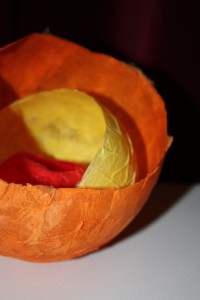Heavenly Curtains
March 25th, 2012
I drew my inspiration for my first creative piece from the Knappert reading from the fourth week, which recounted stories about Mohammad from the Swahili Islamic tradition. I was particularly struck by the story’s description of heaven, which is described as Mohammad ascends to heaven to meet God. The different levels of heaven are made out of different materials (copper, silver, gold, rubies, and diamonds), and are followed by a series of curtains behind which God is present: “At last I arrived at the First Curtain. It was created out of iron; an angel was there to take charge of me and to hand me over to the angel at the next curtain. There were altogether 70,000 curtains separating the divine presence from the rest of creation. The curtains were made from every conceivable substance or element.” The purpose of these curtains is never explicitly explained, but it seems that they are a barrier between the human and the divine, the last separation before humans are brought into the presence of God. One must literally pass through all the elements before coming into God’s presence.
The idea of a veiled divine presence appealed to me, since to me it illustrated the different levels of understanding that humans must go through before they are able to find God. I decided to create a symbolic representation of this divide between the human and divine in sculpture form. God is represented as a light; the different curtains are represented by three different spheres created out of different colored tissue paper. Although originally I had conceived of more than three different spheres, made out of different materials including thread, ribbon, tissue, paper, in order to better approximate the 70,000 curtains described, technical failures resulted in just three differently colored tissue paper spheres. Though it was difficult to photograph how the light penetrated through all of the shades, the idea was that the light would be visible even when the candle itself was obscured—an indication of how overwhelmingly bright the light would be once the shades were removed.
Something that struck me as I completed the project was the fact that the spheres were constructed around negative space: the method that I used to create them was to blow up a balloon, to which I glued pieces of tissue paper. After drying, the balloon was popped, but the shell of tissue paper remained. It is a standard papier mache technique, but in the context of this project it seems particularly appropriate. The story illustrates the simultaneous longing for God and striving and longing to come into his presence and the overwhelming sensation of his presence: when Mohammad passes the last curtain, he faints, presumably out of ecstasy at literally coming into God’s presence. The negative/empty space that filled the balloons, when the candle inside is lit, is transformed from being merely shells to being receptacles of Godly presence, just as humans are filled with divine light upon becoming one with God.

April 14th, 2012 at 10:37 am
Thanks for any other excellent article. Where else may just anybody get that kind of information in such an ideal manner of writing? I’ve a presentation subsequent week, and I’m at the look for such information.
April 23rd, 2012 at 8:34 pm
There are certainly plenty of details like that to take into consideration. That may be a nice level to carry up. I supply the thoughts above as normal inspiration however clearly there are questions like the one you carry up where a very powerful thing can be working in trustworthy good faith. I don?t know if best practices have emerged around things like that, but I am sure that your job is clearly identified as a fair game. Both girls and boys feel the affect of only a moment’s pleasure, for the remainder of their lives.